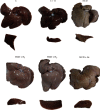Hepatoprotective Effects of a Novel Trihoney against Nonalcoholic Fatty Liver Disease: A Comparative Study with Atorvastatin
- PMID: 33132768
- PMCID: PMC7568805
- DOI: 10.1155/2020/4503253
Hepatoprotective Effects of a Novel Trihoney against Nonalcoholic Fatty Liver Disease: A Comparative Study with Atorvastatin
Abstract
Nonalcoholic fatty liver disease (NAFLD) is the most prevalent chronic liver disorder worldwide with no curative therapy. The aim of this study was to investigate the hepatoprotective effects of a novel Trihoney against biochemical and histological manifestations of NAFLD in hypercholesterolemic rabbits. Methodology. Forty-eight male New Zealand white (NZW) rabbits were grouped into normal diet (C), normal diet with 0.6 g/kg/day of Trihoney (C + H), 1% cholesterol diet (HCD), 1% cholesterol diet with 0.3 g/kg/day of Trihoney (HCD + H1), 1% cholesterol diet with 0.6 g/kg/day of Trihoney (HCD + H2), and 1% cholesterol diet with 2 mg/kg/day of atorvastatin (HCD + At.). Animals were sacrificed after 12 weeks of treatment. Serum lipids and liver function test (LFT) were measured prior to and at the endpoint of the experiment for total cholesterol (TC), low-density lipoprotein (LDL-c), alanine aminotransferase (ALT), aspartate aminotransferase (AST), alkaline phosphatase (ALP), gamma-glutamyl transferase (GGT), and total bilirubin (T. Bil.). Liver was processed for histopathology study. Liver homogenate was analysed for oxidative stress parameters: superoxide dismutase (SOD), glutathione peroxidase (GPx), and malondialdehyde (MDA). Results. Lipid analysis approved the induction of hypercholesterolemia. A significant elevation (p < 0.01) of serum AST and ALT levels showed by the HCD group was compared to C and C + H groups. Trihoney exhibited a significant reduction (p < 0.001) of AST and ALT compared to the HCD group. Likewise, AST and ALT reduced significantly in the HCD + At. group (p < 0.001). Trihoney supplementation induced significant (p < 0.05) enhancement of SOD and GPx activities. Atorvastatin treatment was associated with significant (p < 0.05) reduction of SOD and GPx activities in the liver. Trihoney and atorvastatin showed marked (p < 0.001) reduction of hepatic lipid peroxidation. Trihoney showed histological protection against progression of NAFLD to nonalcoholic steatohepatitis (NASH). Atorvastatin exhibited no beneficial impact on hepatic architecture. Conclusion. Trihoney was able to maintain normal liver function and showed hepatoprotection against progression of NAFLD to NASH probably through hypocholesterolaemic and antioxidant functions.
Copyright © 2020 Hamad Abdulsalam Hamad Alfarisi et al.
Conflict of interest statement
The authors declare that there are no conflicts of interest regarding the publication of this paper.
Figures



Similar articles
-
Ameliorating effect of probiotic on nonalcoholic fatty liver disease and lipolytic gene expression in rabbits.Sci Rep. 2023 Apr 18;13(1):6312. doi: 10.1038/s41598-023-32584-7. Sci Rep. 2023. PMID: 37072469 Free PMC article.
-
Dietary Supplementation with Hazelnut Oil Reduces Serum Hyperlipidemia and Ameliorates the Progression of Nonalcoholic Fatty Liver Disease in Hamsters Fed a High-Cholesterol Diet.Nutrients. 2019 Sep 14;11(9):2224. doi: 10.3390/nu11092224. Nutrients. 2019. PMID: 31540081 Free PMC article.
-
Hepatoprotective effects of Shilajit on high fat-diet induced non-alcoholic fatty liver disease (NAFLD) in rats.Horm Mol Biol Clin Investig. 2020 Feb 14;41(1):/j/hmbci.2020.41.issue-1/hmbci-2019-0040/hmbci-2019-0040.xml. doi: 10.1515/hmbci-2019-0040. Horm Mol Biol Clin Investig. 2020. PMID: 32083445
-
Raspberry ketone protects rats fed high-fat diets against nonalcoholic steatohepatitis.J Med Food. 2012 May;15(5):495-503. doi: 10.1089/jmf.2011.1717. J Med Food. 2012. PMID: 22551412 Free PMC article.
-
Ursodeoxycholic Acid's Effectiveness in the Management of Nonalcoholic Fatty Liver Disease: A Systematic Review and Meta-analysis.Euroasian J Hepatogastroenterol. 2024 Jan-Jun;14(1):92-98. doi: 10.5005/jp-journals-10018-1434. Euroasian J Hepatogastroenterol. 2024. PMID: 39022193 Free PMC article. Review.
Cited by
-
Metabolic dysfunction-associated steatotic liver disease-induced changes in the antioxidant system: a review.Arch Toxicol. 2025 Jan;99(1):1-22. doi: 10.1007/s00204-024-03889-x. Epub 2024 Oct 23. Arch Toxicol. 2025. PMID: 39443317 Free PMC article. Review.
References
Publication types
MeSH terms
Substances
LinkOut - more resources
Full Text Sources
Other Literature Sources
Medical
Miscellaneous

